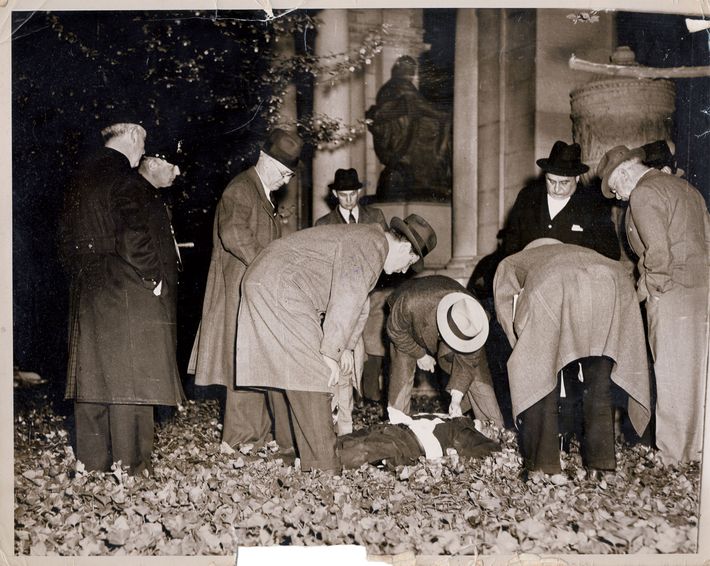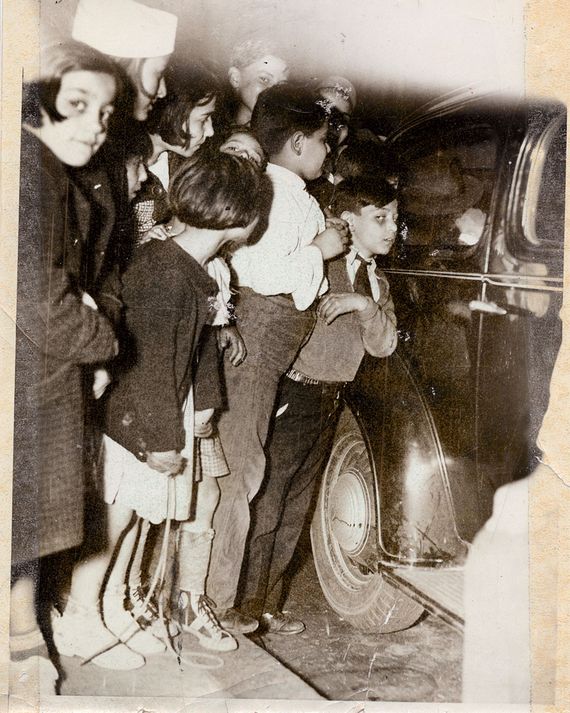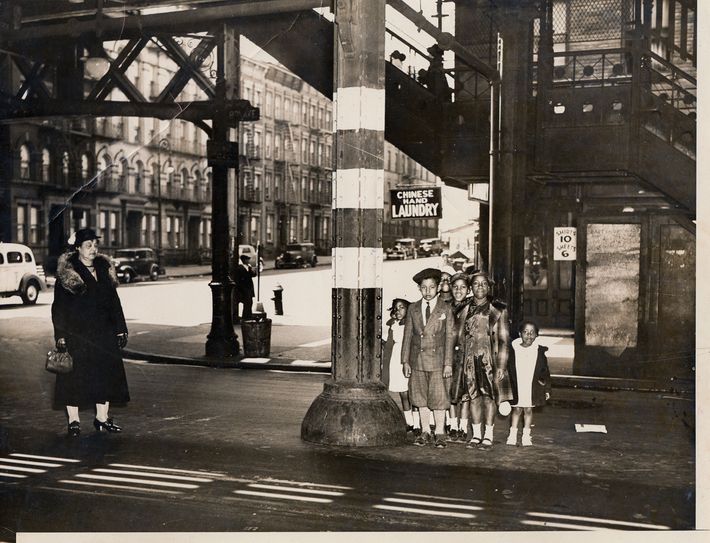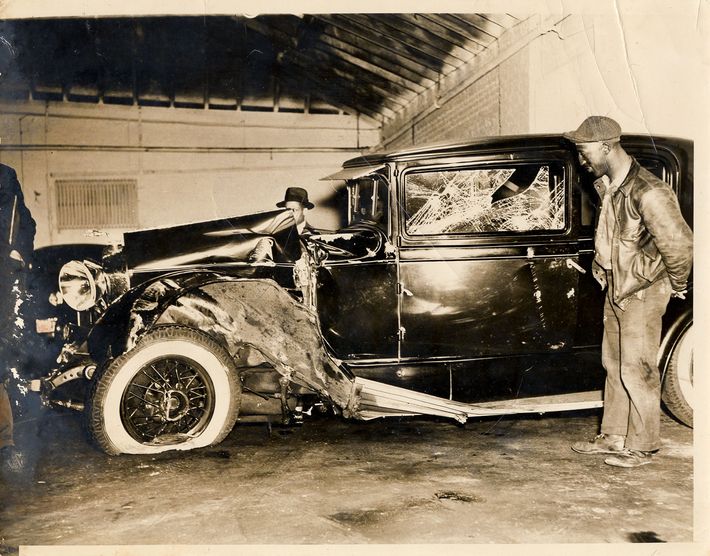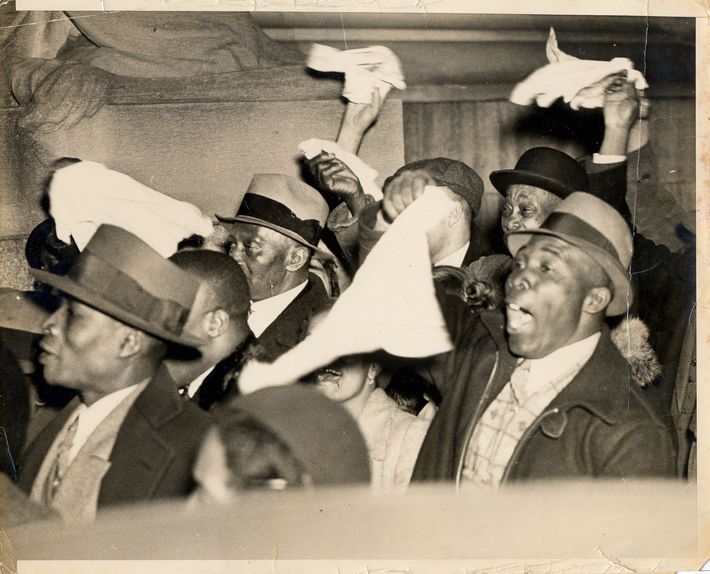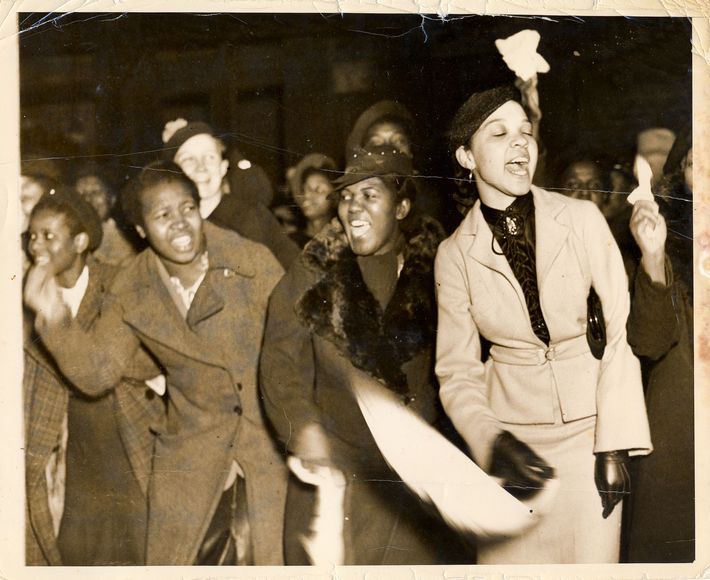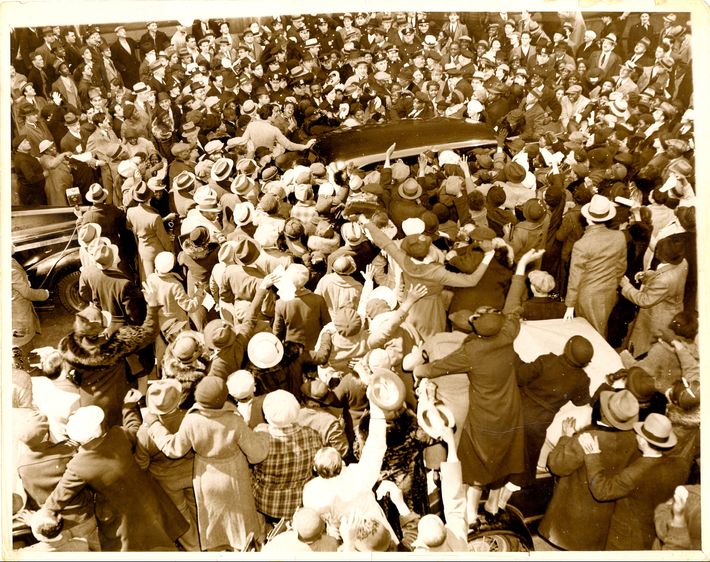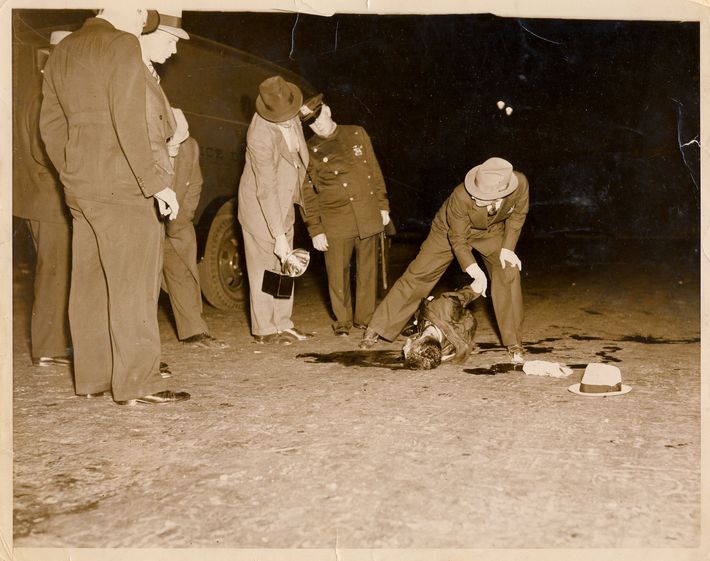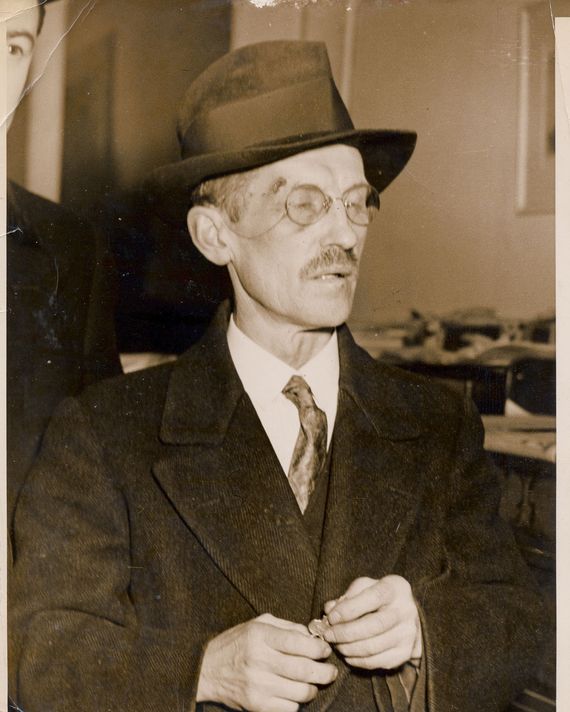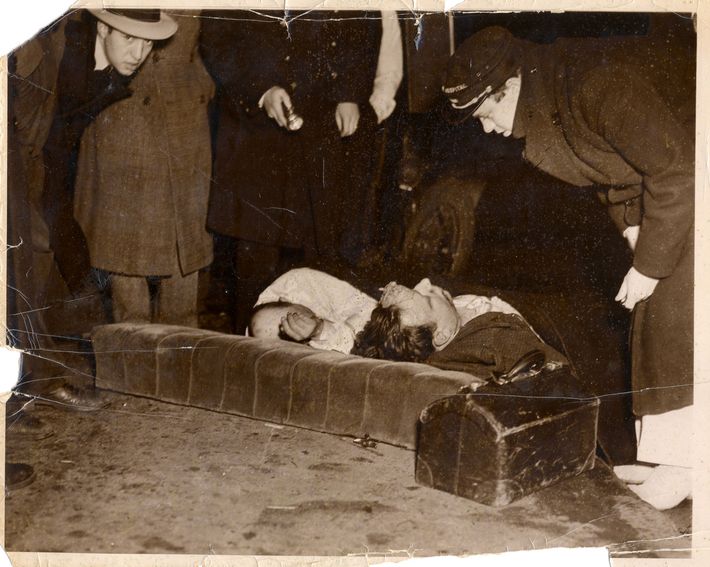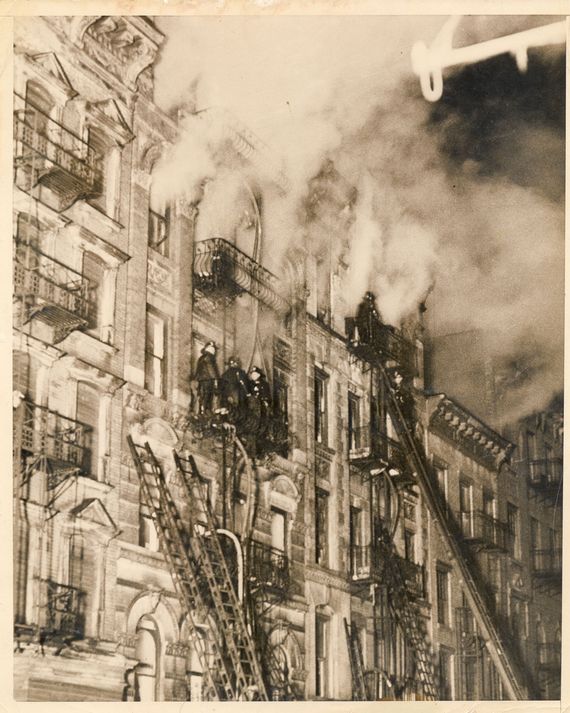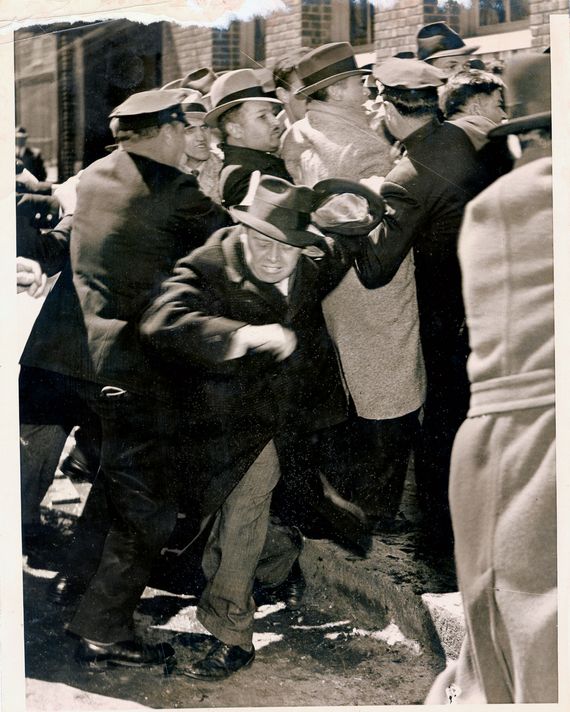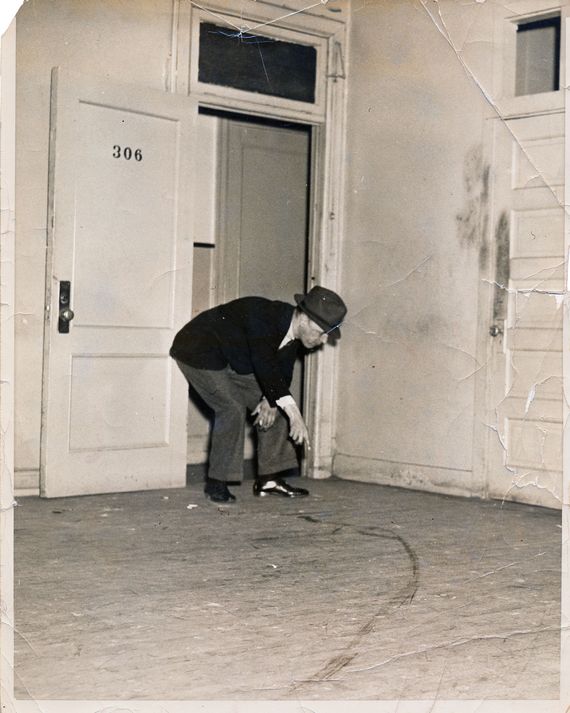
In 1970, an artist named David Young bought a box of 1930s news photos at a secondhand store in Philadelphia. He just liked the look of them, he says now, and he stuck a couple on the wall of his studio with masking tape. Eventually, he moved to Seattle, and the box of photos went into a kitchen cabinet and stayed there.
Earlier this year, he pulled it out for a look. The prints had, over the years, curled up into a tight roll, and he had to slide them apart from one end. That’s when he noticed that most of them bore a photographer’s stamp on the back: PHOTO BY A. FELLIG. Five decades ago, he had not been able to Google that name, but in 2019 he quickly discovered that Arthur Fellig was the given name of Weegee, the legendary crime-and-mayhem photographer of mid-century New York. Young soon got in touch with me. (I’m Weegee’s biographer.) He couldn’t send me scans because the prints were so tightly curled, but he did send me a snapshot of them, and I recognized Weegee’s handwriting on several of the backs. Eventually, based on some further Googling, Young rigged up a homemade humidifying chamber that allowed him to flatten the photographs — gently — and get them on a scanner.
When they hit my in-box, I about fell out of my chair. There are 73 prints, and 49 of them bear Weegee’s stamp; the unmarked ones too are surely his. Not one of these pictures is duplicated in the biggest collection of Weegee’s work, which is his own estate, held at the International Center of Photography. During the research on my book Flash: The Making of Weegee the Famous, I had seen a few of these photos, or variants of them, in the New York newspapers where they’d originally been published. I’d also found a stray print of one for sale on eBay, and seen another in a Swann Galleries auction catalogue. But most were new to both me and the ICP curators. To my eye, several of them rank with Weegee’s best work. Christopher George, the archivist who manages the Weegee collection at ICP, agrees: “An extraordinary find,” he told me. “It’s like discovering 73 unknown poems by Walt Whitman or unearthing a novella by Melville.” Even the second-string photos are pretty good.
I’ve been able to attach about 80 percent of the photographs to particular news stories and thus to particular days. (Nights, really.) Nearly all were shot in April and May 1937. There are two tenement fires, a couple of nasty car crashes, and at least eight murders represented. “This is when Fellig was Fellig — a hardworking photographer, working constantly,” George says. “We can see his method: taking several photos of an event, making them into a story, sometimes numbering the margins.” To my knowledge, not one of these pictures has been published for 82 years.
This isn’t the first such discovery from Weegee’s newshound years, which ran from about 1935 to 1947. In 2008, a trunk containing a couple of hundred photos and some letters surfaced at a Kentucky yard sale. Those pictures mostly went into a museum collection, though some of the material went on the open market. Young, who is not a rich man, seems floored by his own Antiques Roadshow–ish discovery. It’s hard to put a monetary value on this cache because gallery and auction prices vary so widely, but individual prints of Weegee’s very best pictures have sold for well into five figures. (Unfamiliar images like this would likely go for less, though you never know.) One thing is for sure: He’s not putting masking tape on any of the other pictures.
Spurned Suitor Clubs Violinist to Death (top photo)
April 18, 1937: Julia Nussenbaum, a young Juilliard-trained violinist who performed under the name Tania Lubova, was killed with a claw hammer in a Times Square rehearsal studio. The murderer turned out to be a theatrical booker named Mischa Ross, who had been interested in her romantically and would be classified today as a stalker. He was caught the next day — admitting he’d done it but saying she had hit him first — and was later sentenced to 35 years in Sing Sing. In this photo, a detective points out a smear of blood where Nussenbaum’s dying body had been dragged across the rehearsal-room floor.
Corpse Found in Bryant Park
May 5, 1937: That’s Stanley Mannex, a 47-year-old Turkish immigrant, in the ivy. His body turned up early that morning behind the New York Public Library.
Single Mom, Desperate to Re-Wed, Stabs, Torches Her Children
May 15, 1937: Helen Tiernan, a single mother of two, was trying to get her boyfriend, a Greek immigrant named George Christodulus — a.k.a. George Christie — to marry her. George (seen below right, in black hat) didn’t want the kids. So Helen (below left, in light-colored coat) told her children they were going on a picnic, took them into the Long Island woods, stabbed both, and set her daughter afire. The girl, who was 7 and also named Helen, died; the son, Jimmy, age 4, survived. The elder Helen got 20 years to life. Her confession let George off the hook, whereupon he was put up for deportation back to Greece. Jimmy went to a foster home. The kids peering into the car (seen above) are jeering at George after his arrest.
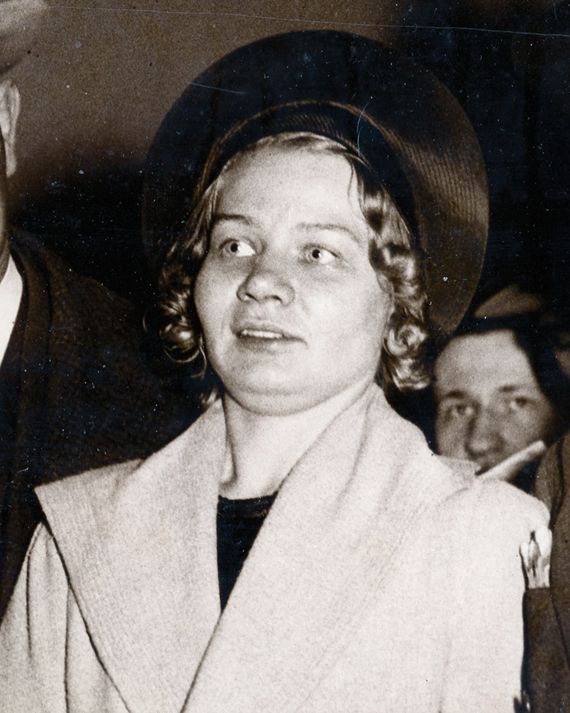
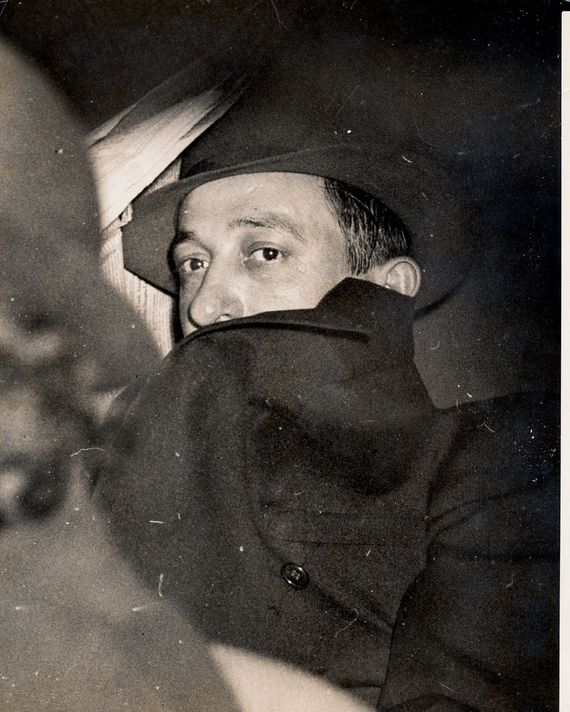
Welfare Rolls Purged; Family on Public Assistance Deported to Pennsylvania Hometown
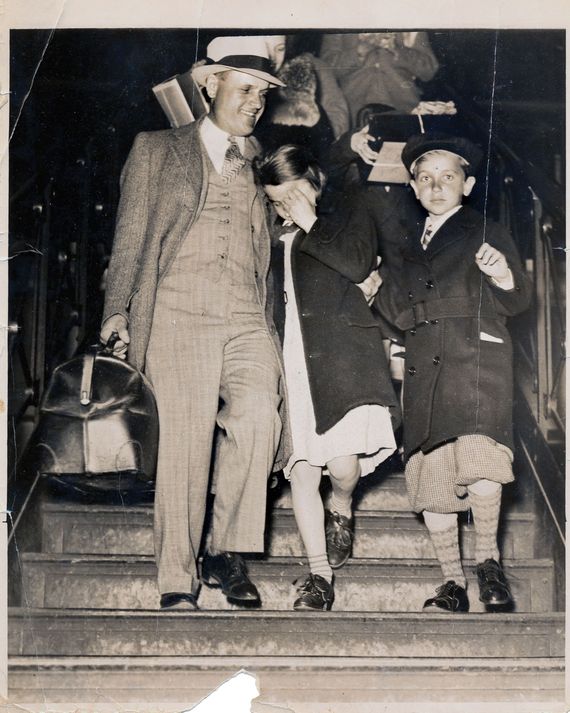
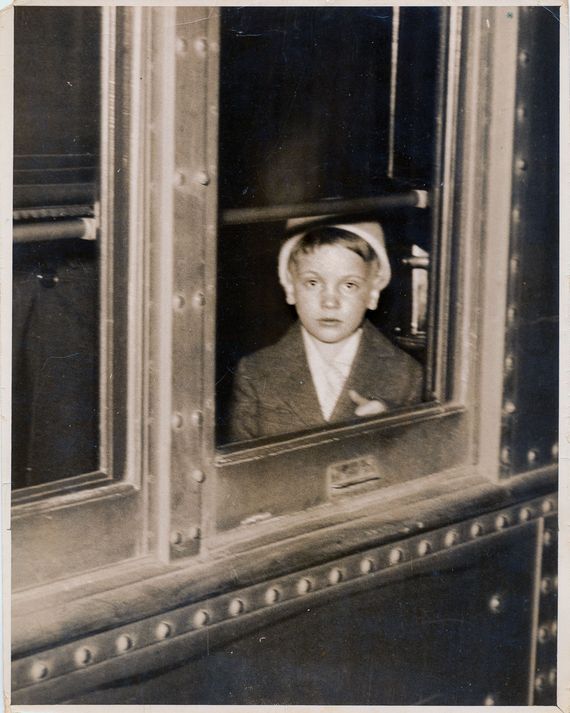
April 20, 1937: Tony Benedetti was a single father of four from Uniontown, Pennsylvania, underemployed in New York during the Depression. Under a newly passed New York law looking to reduce the number of public charges, his family became the first in the state to be deported — put on a train at Penn Station back to Fayette County, where they were received by local welfare officials.
Kids Gawk at Car-Wreck Site; Observer Unimpressed
April 25, 1937: Throughout his news career, Weegee’s signature move was to photograph the observers of an event instead of the event itself. Earlier on this day, the actor Stepin Fetchit had crashed his car into this el-train pillar at Eighth Avenue and 135th Street. Weegee shot the wreck after it had been towed — see image below— and also appears to have set up this photo of neighborhood children hanging around the site as a woman looks on disapprovingly. The image carries a hint of his most famous picture, The Critic, made six years later — and also staged.
Crash Kills 1; Hurts 4; Tragic Mix of Liquor, Gasoline
May 17, 1937: The driver of this car — who, we can assume from the empty bottles, had been drinking — crashed his automobile into another at the intersection of South Portland and Fulton Streets in Fort Greene, Brooklyn. The impact knocked this car into the path of a trolley, flipping the automobile over and crushing it. One passenger, Nelson Wilson, age 24, was killed; the driver and several other riders were hurt. The New York Evening Journal turned it into a lesson, writing, “Look at the pictures again, Mr. Motorist, and remember those empty bottles,” under the headline GRIM REAPER THUMBS A LIFT WHEN YOU ‘GO TO TOWN.’
Hallelujah! Evangelist’s Followers Praise His Release From Custody
April 22, 1937: Father Divine was a prominent figure in Depression-era New York — a preacher, plausibly described as the leader of a Christian cult, whose followers believed him to be the Messiah. At three in the morning on April 20, as 2,500 of his disciples met for a late-night meal, a process server also arrived, leading to an altercation in which the visitor was stabbed. Father Divine hid out in Connecticut for a day, then turned himself in and was brought back to New York for questioning. By the time he was let go from police headquarters on the morning of the 22nd, hundreds of his followers — known as his “Angels” — had gathered, shouting and keening and then celebrating as he climbed into his Rolls-Royce for the trip back uptown. The woman in the light-colored suit was chanting “Father Divine is God! Father Divine is God!”
Murder on a New York Sidewalk
Date unknown: Weegee’s first exhibition of photographs, in 1940, was titled “Murder Is My Business,” and he reveled in his reputation as a documentarian of the recently bumped-off. “I made the stiff look real cozy, as if he were taking a short nap” is how he once described his job. This one — we don’t yet know where it happened — has all the hallmarks of his best murder photos: The detectives are impassive, the lantern that one of them is holding adds a secondary focus, the victim’s hat is perfectly placed — and, if you don’t look too hard at the blood on the sidewalk, he could indeed, maybe, be a drunk just taking that short nap.
After Wife and Daughter Are Slain, Local Upholsterer Is Arrested, Then Acquitted
March 29, 1937 (approx.): That’s Joseph Gedeon, shortly after his wife, Mary, and daughter, Veronica, along with a boarder in their apartment, had been murdered in their home at 316 East 50th Street. Veronica was a young model, and racy pictures of her very quickly flooded the newspapers and turned this triple homicide into even more of a sensation. Briefly considered a suspect, Joseph — who worked as an upholsterer, causing the tabloids to run photos of suspicious-looking needles and other tools — was eventually cleared; Robert Irwin, a sculptor, turned out to be the killer, and his lawyer made a pioneering use of the insanity defense, saving him from the electric chair. Irwin died in an institution in 1975.
Teen Couple Murders Mother With Hatchet
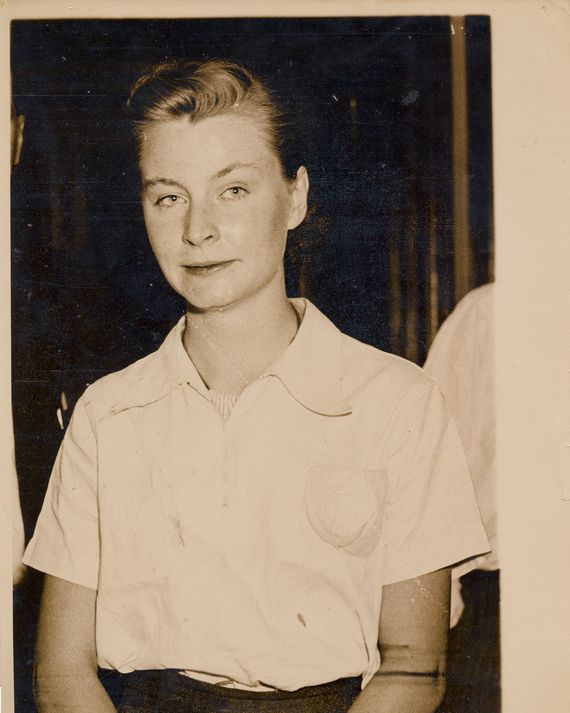
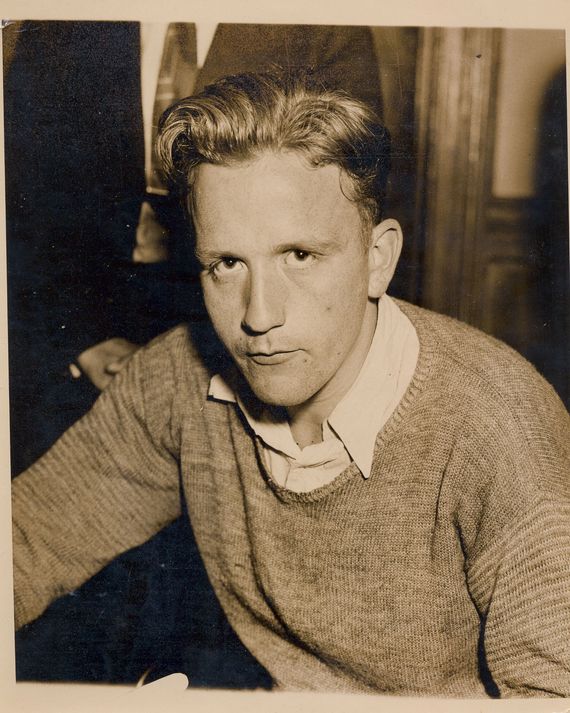
August 1, 1936: A 5 a.m. photo session at the Bayonne, New Jersey, police station led to these two portraits. Gladys Macknight, 17 years old, and her boyfriend, Donald Wightman, 18, were a pair of clean-cut rich kids, returning from a tennis date. Back at the Macknights’ place, the couple and her mother got into an argument, one that escalated to the point where Gladys buried a hatchet in Mom’s head. The couple fled, then came back to town a few hours later and turned themselves in. Weegee caught the story from an early edition of the Daily News (which didn’t have photos yet) and raced to Jersey to catch it in time for the afternoon dailies’ deadlines, and lobbed a picture of Gladys onto the front page of the Post. At the trial, each tried to sell the other out, telling somewhat conflicting stories. Both went to prison. Much more about the story here.
Bloodied Survivors of a Downtown Crash
January 31, 1937: The car was rammed into a light pole at Franklin and West Streets. All three occupants, including the driver, were drunk, and all were hurt. “I have never seen so much blood — before or since,” Weegee told a Popular Photography reporter who was profiling him a few months later. “The police gave me a break and I got a marvelous shot of the guy in the front seat with blood criss-crossing his face like swollen veins. I shot the second man laid out on the ground.” (That’s the image you see here, as he lies on an upholstered seat that’s been removed from the car.) “The third fellow I caught on the stretcher. I also made plenty of shots of the wrecked car.”
Lower East Side Tenements Burn, Killing 3, Injuring 15
March 4, 1937: A late-night fire (one of literally hundreds that Weegee covered; they occurred constantly in the tenements) began at 139 Suffolk Street, spread to several adjacent buildings, and took three lives. Weegee seems to have been the only press photographer who made it there before the fire was out: This photograph ran in at least four of the nine New York dailies, and he got the front page of the Post and the World-Telegram.
Strikers Caught in Fracas
Possibly April 30, 1937: It’s not a sure ID, but — based on some similar photographs that appeared in the papers in these weeks — this seems to be a picture from a strike at the Long Island Press in April and May 1937. Unquestionably, though, it shows Weegee’s eagerness to catch action on film, a skill he came by through constant attentiveness. He lived in a tiny hovel directly across from police headquarters, with a radio tuned to the cops’ frequency. When a good story came over the air, he could be downstairs and on his way in seconds. That in turn meant that he could (sometimes) get there first and land himself an exclusive, which — as a freelancer, covering the stuff that the staff photographers didn’t get to — he knew would pay off.
*A version of this article appears in the May 13, 2019, issue of New York Magazine. Subscribe Now!



